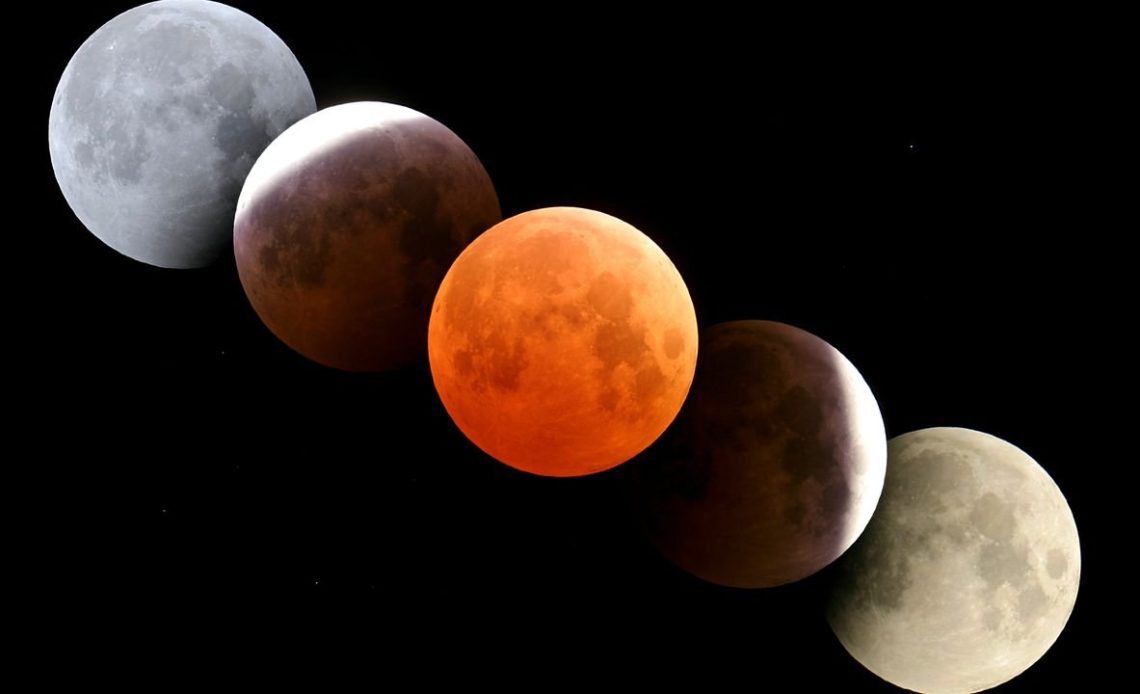
On March 2-4, 2026, a total lunar eclipse will be visible from Western North America, Australia, New Zealand and East Asia, with a “blood moon” appearing for 58 minutes.
Lunar eclipses happen when Earth is between the sun and a full moon. During the event, the moon moves through Earth’s umbra, the dark center of its shadow.
Where will the March 2026 total lunar eclipse be visible?
The best views of the March 2026 total lunar eclipse will be from Western North America, Australia, New Zealand, East Asia and the Pacific. According to Time and Date, only 2% of the world’s population — 176 million people — will see all of the phases (penumbral, partial and total) of the eclipse. However, almost 31% — 2.5 billion — will see all of totality, the “blood moon” phase. Viewing conditions will depend on the local weather, with northwest Mexico, the southwest U.S. and inland Australia statistically offering the best odds of clear skies.

What will happen during the total lunar eclipse?
The March 2-4, 2026, event will be the first total lunar eclipse anywhere in the world since Sept. 7-8, 2025, and the last until Dec. 31, 2028 to Jan. 1, 2029, when a total lunar eclipse will occur on New Year’s Eve.
During the March 2026 total lunar eclipse, the full “Worm Moon” will rise and, later that night, pass into Earth’s umbral shadow. As it does, the full moon will dim and gradually turn reddish-orange, which is why it’s called a “blood moon.” Totality — when the entire lunar surface appears reddish-orange — will last 58 minutes. However, the entire eclipse — including the penumbral and partial phases — will last 5 hours, 38 minutes.
This total lunar eclipse will occur seven days before the moon reaches apogee — its farthest point from Earth on its slightly elliptical orbit — making it of average apparent size.
What time is the March 2026 total lunar eclipse in North America?
Lunar eclipses occur at the same universal time worldwide, but the local clock time and whether the moon is above the horizon vary by location. This one will happen between 08:44 and 14:22 UTC on Tuesday, March 3, 2026 (3:44 to 9:22 a.m. EST), with the spectacular 58-minute-long totality — when the entire lunar surface will be reddish — happening between 11:04 and 12:02 UTC. That translates to the following local times in North America:
- Eastern time: 6:04-7:02 a.m. EST on March 3, 2026 (the moon will set during totality in the Eastern time zone)
- Central time: 5:04-6:02 a.m. CST on March 3, 2026
- Mountain time: 4:04-5:02 a.m. MST on March 3, 2026
- Pacific time: 3:04-4:02 a.m PST on March 3, 2026
- Alaska time: 2:04-3:02 a.m. AKST on March 3, 2026
- Hawaii time: 1:04-2:02 a.m. HST on March 3, 2026
These are the times for totality only. However, it’s worth looking at the moon about 75 minutes before these times to see the edge of Earth’s shadow inch across the lunar surface during the partial phases (and vice versa after totality, though for North America, the moon will be setting).

What time is the March 2026 total lunar eclipse in the Asia-Pacific?
In the Asia-Pacific, the eclipse will occur the night of March 3-4. In parts of Southeast Asia, totality will begin as the full moon rises, dulling the effect.
Here’s when totality will occur in various locations within the Asia-Pacific:
- New Zealand: 12:04-1:02 a.m. NZDT on March 4, 2026
- Sydney: 10:04-11:02 p.m. AEDT on March 3, 2026
- Brisbane, Australia: 9:04-10:02 p.m. AEST on March 3, 2026
- Adelaide, Australia: 9:34-10:32 p.m. ACDT on March 3, 2026
- Darwin, Australia: 8:34-9:32 p.m. on March 3, 2026
- Perth, Australia: 7:04-8:02 p.m. on March 3, 2026
- Tokyo: 8:04-9:02 p.m. JST on March 3, 2026
- Seoul: 8:04-9:02 p.m. KST on March 3, 2026
- Beijing: 7:04-8:02 p.m. CST on March 3, 2026
- Hong Kong: 7:04-8:02 p.m. HKT on March 3, 2026

After March 2026, when is the next total lunar eclipse?
Here are the dates and locations for upcoming total lunar eclipses, plus a deep partial eclipse:
- Aug. 27-28, 2026: A deep 93% partial lunar eclipse will be visible from parts of Europe, Western Asia, Africa, North America, South America, the Pacific Ocean, the Atlantic Ocean, the Indian Ocean and Antarctica.
- Dec. 31-Jan. 1, 2028-2029: A total lunar eclipse will be visible from Europe, Asia, Australia, Africa, Northern and Western North America, the Pacific Ocean, the Atlantic Ocean, the Indian Ocean and the Arctic.
- June 25-26, 2029: A total lunar eclipse will be visible from Europe, Western Asia, Africa, North America, South America, the Pacific Ocean, the Atlantic Ocean, the Indian Ocean and Antarctica.
- Dec. 20-21, 2029: A total lunar eclipse will be visible from Europe, Asia, Northern and Western Australia, Africa, North America, South America, the Pacific, the Atlantic, the Indian Ocean and the Arctic.
Additional resources:
Want to look further ahead? You can find a concise summary of lunar eclipses out to 2026 here on Space.com. Read more about solar and lunar eclipses on EclipseWise.com, a website dedicated to predictions of eclipses, and find beautiful maps on eclipse cartographer Michael Zeiler’s EclipseAtlas.com and interactive Google Maps on Xavier Jubier’s eclipse website. You can find climate and weather predictions by meteorologist Jay Anderson on eclipsophile.com.
Bibliography
Jubier, X. (n.d.). Lunar eclipses: Interactive Google Maps. Retrieved Sept. 1, 2025, from http://xjubier.free.fr/en/site_pages/Lunar_Eclipses.html
Time and Date. (n.d.). 2-3 March 2026 Total Lunar Eclipse (Blood Moon). Retrieved Sept. 1, 2025, from: https://www.timeanddate.com/eclipse/lunar/2026-march-3
Cameron Smith, I. Total Lunar Eclipse of Mar. 3, 2026 AD. Retrieved Sept. 1, 2025, from: https://moonblink.info/Eclipse/eclipse/2026_03_03
Author: Jamie Carter
Source: Space.com
Reviewed By: Editorial Team



